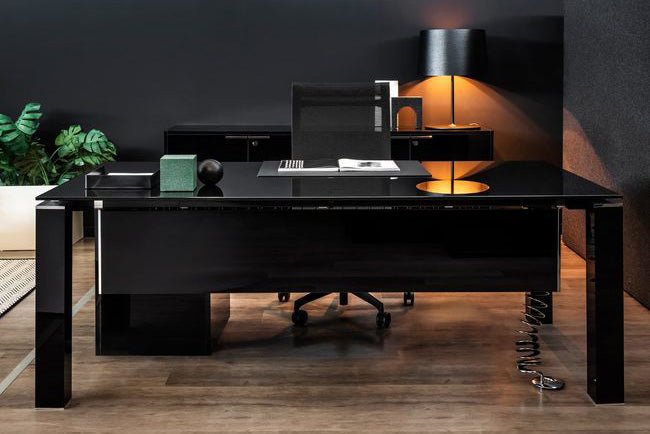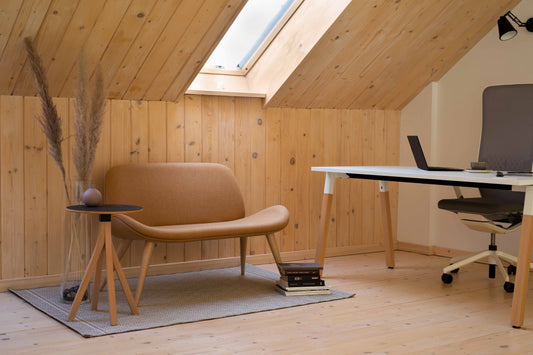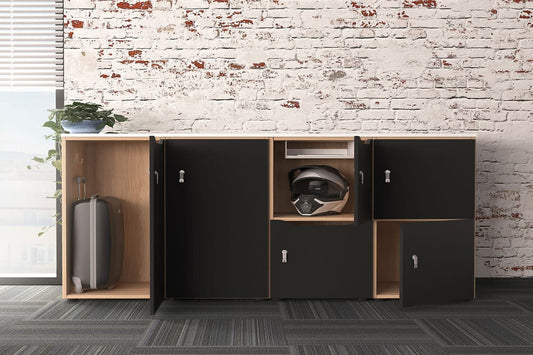Space design and job optimization | Reading time approx. 2 min 🕒
So you will find the optimal office lighting
Are you a savings scarf that tries to save every crease in the electricity bill and therefore work in the dim light, as if you were a mysterious character in a James Bond film? The dim atmosphere has a certain charm, but when it comes to your productivity and eye health, it's time to get the light on! The good news: Optimal office lighting does not necessarily bring your electricity costs to explode. We'll tell you tips on what about the Lighting at the workplace arrives.

What effects does office lighting have on us?
Do you often feel sluggish and limp at work? Do you have eye and headaches at the latest in the afternoon? All of this can have to do with the lighting at your workplace. This has a major impact on Your health, well -being and your work performance. You can see what advantages have ergonomic office lighting here at a glance:
- The optimal office lighting reduces the load on the eyes and prevents tiredness.
- The correct illumination improves concentration and increases efficiency.
- Natural light and well -designed artificial light promote the mood and can even alleviate depressive moods.
- Modern, energy -efficient lighting solutions not only protect the environment, but also your wallet.
- Individually adjustable light sources enable you to adapt the light depending on the time of day and task.
With the optimal office lighting, you take a big step towards a healthier and more productive work environment.
What lamps are there?
Luminaries are the heart of every lighting solution and decisively decide on quality, efficiency and atmosphere of light. The choice of the right lamp depends on your individual needs. These options are available to you:
- Incandescent lamps: Although they are known for their warm light, they were largely replaced by more efficient technologies due to their low efficiency and short lifespan.
- LEDs (light emits): Known for your energy efficiency and durability, offer a wide range of color temperatures and are dimmable. Ideal for sustainable and cost -saving lighting.
- Halogen lamps: Offer a warm, light light and better color rendering compared to conventional light bulbs. They are dimmable, but have a shorter lifespan and higher energy consumption than LEDs.
- Compact light lamps (CFLS): These energy -saving lamps need less energy than conventional light bulbs and last longer. However, their time up to full brightness and the mercury it contains are disadvantages.
What does the optimal office lighting look like?
Before we can respond to the details, it is important to know the difference between indirect and direct light. Indirect lighting Reflecting on the walls and ceilings and thereby creates a uniform light distribution that illuminates the room without hard shadows or glare effects. This ensures a soft, inviting atmosphere. Direct lighting In contrast, the light focuses on certain work areas - ideal for tasks that require a high concentration. A combination of both types of lighting enables flexible adaptation to different activities and preferences. However, the most effective light source is even more important: that daylight. Natural light from the outside increases the general illuminance in the room and has a positive impact on our mood and health. Maxify daylight by Desks Set up near windows and ensures a good distribution of the light, so it should always be a priority when planning the office lighting.
Illuminance
The illuminance, measured in Lux, indicates how light an area is illuminated. For office workstations, a lighting thickness of at least 500 lux is recommended to minimize the strain of the eyes and improve readability. Higher values of up to 1,000 lux can further increase attention and well -being, especially with detailed tasks.
Glare and reflection
Good office lighting avoids direct glare (e.g. by non -shielded light sources) and reflex fade (e.g. through glossy surfaces). Adjustable blinds, Dividing walls Or matt screens can help minimize these problems.
Light color and color rendering
The light color, expressed in Kelvin, influences the atmosphere and can promote well -being and productivity. Warm -white light (up to 3,300 K) creates a cozy atmosphere, while cold white light (over 5,300 K) can support the concentration. The color rendering (CRI) is also important because it determines how natural and lively colors appear under the artificial light. A high CRI value (over 80) is essential for an accurate color perception.
What types of lighting are there?
Now it's time to get to the fact that you have not only the choice between different lamps, but also between various lamps. We look at which these are now.
Desk lights:
Desk lights offer direct light exactly where it is needed - to your work area. They are ideal for tasks that require high concentration, such as reading documents or working on the computer. Many models have adjustable arms and heads that enable a precise alignment of the light, as well as dimming functions in order to adapt the light intensity as required.
Ceiling lights:
Ceiling lights offer general lighting for the entire room. They are available in different styles and performance strengths to ensure even illumination. Ceiling lights are particularly effective in combination with other light sources to minimize shadow areas and create a pleasant working environment.
Pendant lights:
Pendant lights hang down from the ceiling and can be placed over certain areas such as meeting tables or work islands in order to offer targeted lighting. They are ideal for setting accents or creating a certain mood in the room without affecting a view of screens.
Floor lamps:
Floor lamps are a flexible solution that can be set up in addition to desks or in reading corners. They offer both direct and indirect light and are easy to reposition in order to meet the changing requirements in everyday office life. Floor lamps are ideal for lightening dark corners or serving as a supplementary light source next to the primary lighting.
Accent lighting:
Accent lighting is used to highlight certain elements in the room, such as works of art, plants or special design features. It can create an atmosphere that promotes creativity and well -being at work. Accent lights can be implemented in the form of wall lamps, radiators or LED ligaments and contribute to lending personality and depth to an office.
So end with eerie dim light: pull the curtain and let the sun in - For a good mood, fit eyes and a bright brains.
Trending magazine articles
-
Raumgestaltung und Arbeitsplatzoptimierung
Skandinavisches Design im Büro
-
Product Consultation
Lockers in the office
-
Ergonomie und Gesundheit
Proper seating in the office




